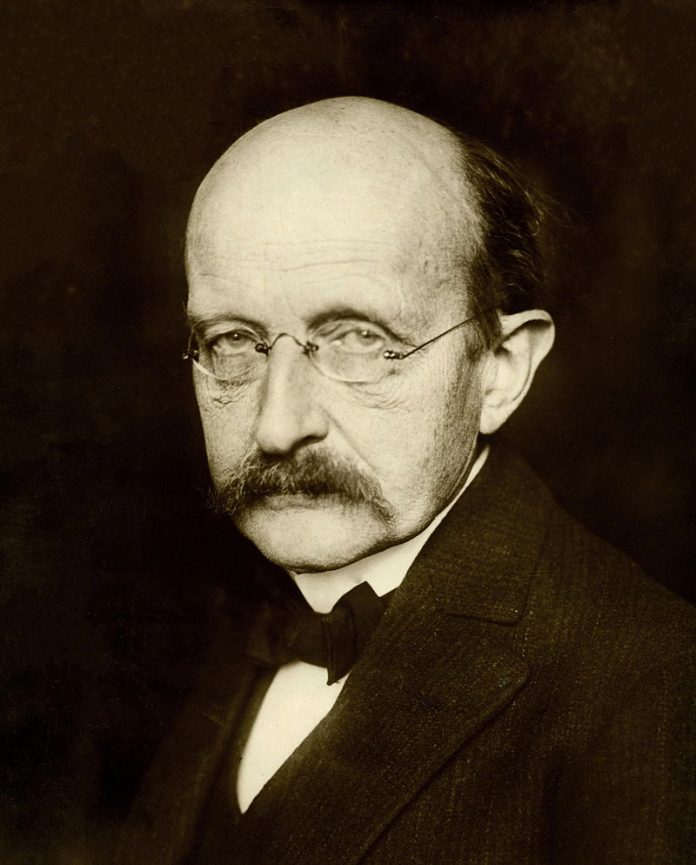Suppose for instance someone maintained that there is a minimum magnitude; that man with his minimum would shake the foundations of mathematics.
So prophesied Aristotle more twenty-four centuries ago.[1] And, as with many things Aristotelian, how right he was.
Why it took that long for that ‘man with his minimum’ to come along is a bit of a mystery (one which Father Jaki ponders, and perhaps the theme of another reflection), but come along he eventually did, at the very dawn of the last century. And he shook not only the foundations of mathematics, but of the world.
It was on October 19th, 1900, that German physicist Max Planck first proposed a theory at the German Physical Society that seemed rather esoteric at the time, as do most original scientific publications. He had discovered that radiation – which includes everything from radio waves, to visible light, all the way to cosmic rays – was composed not of a continuous stream, as was until then theorized, but of individual and indivisible packages of energy, that he called ‘quanta’ (after the Latin for ‘how much’, or a ‘certain amount’ – in the singular, quantum).
This solved the conundrum of the ‘ultraviolet catastrophe’ that had troubled scientists – the theory that if energy from stars and such were poured forth in a continuous stream (like water from a hose), it should have all dissipated in the earliest phase of the universe. What actually happens – weirdly enough – is that such sources ‘husband’ their energy, releasing it only in these discrete quanta. More than that, when other radiating energy hits an object, that object will only release its own corresponding radiation if the incoming energy ‘resonates’ in a specific frequency. There is no a priori reason for this – it just happens.
This is why we have colour. For the electrons revolving around atoms (a limited analogy, for they rather vibrate around atoms) are also quantized. They stay firmly within their specific orbitals, and only jump between them – to another specific orbital – when prompted to do so by specific frequencies of radiation, sort of like an antenna which only picks up a specific radio frequency. Hence, a red object will absorb all visible radiation, except red, which it will radiate out into the world (and our eyes) by this jostling of its electrons.
Things get weirder with what would soon be called ‘quantum physics’. For electrons only ‘exist’ in their quantized orbitals – for when they jump between them, they disappear. For the quanta are discrete, and admit not of fractions, or parts, and are indivisible.
Hence all electromagnetic radiation whizzes around the word (at the speed of light, about 186,000 miles per second) in these specific, quantized frequencies.
And it’s not just energy. For it was later discovered that all matter – protons, neutrons and all the rest – is also quantized, which fits in well with Einstein’s discovery that energy and matter are convertible (E = Mc2 signifying that matter is in some sense energy in a very compressed form).
Hence, if we divide up matter into smaller and smaller bits – a favorite thought experiment of the scholastics and mediaevals, in their own search for that mysterious minimum – we do indeed reach a limit of indivisibility as Aristotle thought, that mighty minimum, the building blocks, if you will, from which all energy and matter is composed. This minimum is governed by a very, very small number, Planck’s constant, 6.626 x 10-34, symbolized by an italicized h (considering that 10-12 is one trillionth, and this is many, many times smaller than that – so these sub-atomic building blocks are very, very tiny)
The energy (E) contained in each quantum is signified by a simple equation:
E = hf
Where f is the frequency of the radiation (or matter, which also vibrates): Hence, the greater the frequency, the greater the energy (which is why X-rays are far more penetrating and damaging than radio or light waves, which are mostly harmless).
All energy, matter, and perhaps even time itself, is composed of discrete multiples of Planck’s constant, and its discovery has indeed shaken our foundations. The science of ‘quantum physics’ has given us access to the very structure of the universe, allowing us not only to investigate, but manipulate energy and matter at their most fundamental level.
Almost all of our modern inventions are based on quantum physics, from radio technology, to the internet, mobile phones, computers, satellites, X-rays, MRI’s, PET scans, chemical bonding and synthetic materials, nuclear power (and bombs), virtual reality – ABBA is about to tour again, as holograms of their thirty-something selves (the ‘real’ band members are now septuagenarians) – and the burgeoning field of artificial intelligence, controlling to some extent almost every aspect of our lives. And the surface is just being scratched.
Whither will all this go? The Pastoral Constitution, Gaudium et Spes, warns, with some degree of hope:
The intellectual nature of the human person is perfected by wisdom and needs to be, for wisdom gently attracts the mind of man to a quest and a love for what is true and good. Steeped in wisdom. man passes through visible realities to those which are unseen. Our era needs such wisdom more than bygone ages if the discoveries made by man are to be further humanized. For the future of the world stands in peril unless wiser men are forthcoming.
A final though in light of this Magisterial caveat on the need for wisdom: Might there be a spiritual analogue to Planck’s mighty minimum? If so, perhaps it is Saint Therese’s ‘little way’, that the smallest act done with great love is far better than the greatest act done with a lack of love, which is really a reiteration of the widow’s last two mites, the mustard seed, or, to journey further back, the sacrifice of Abel, versus that of Cain.
For it is charity, the love of God with all our being, and our neighbour as ourselves, that will truly shake the foundations of the world.
[1] As recounted by Father Stanley Jaki in his indispensable Relevance of Physics, University of Chicago Press, 1966. (p. 33)











